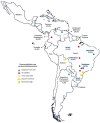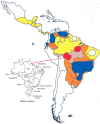New Trends in Paracoccidioidomycosis Epidemiology
- PMID: 29371520
- PMCID: PMC5715958
- DOI: 10.3390/jof3010001
New Trends in Paracoccidioidomycosis Epidemiology
Abstract
Paracoccidioidomycosis is a systemic fungal disease occurring in Latin America and more prevalent in South America. The disease is caused by the dimorphic fungus Paracoccidioides spp. whose major hosts are humans and armadillos. The fungus grows in soil and its infection is associated with exposure to the rural environment and to agricultural activities, with a higher risk in coffee and tobacco plantations. Population studies assessing the reactivity to Paracoccidioides spp. antigens by intradermal reaction or serological tests have detected previous subclinical infections in a significant proportion of healthy individuals living in various endemic countries. Paracoccidioidomycosis-disease is manifested by a small minority of infected individuals. The risk of developing the disease and its type of clinical form are related to the personal and life style characteristics of infected individuals, including genetic background, age, sex, ethnicity, smoking habit, alcohol drinking, and eventual cellular immunosuppression. Brazil, Colombia, Venezuela, Argentina, and Ecuador have endemic areas that had already been defined in the 20th century. The incidence of paracoccidioidomycosis can be altered by climate phenomena and mainly by human migration and occupation of poorly explored territories. In Brazil, the endemy tends to expand towards the North and Center-West around the Amazon Region.
Keywords: Paracoccidioides brasiliensis; Paracoccidioides lutzii; epidemiology; paracoccidioidomycosis.
Conflict of interest statement
The author declares no conflict of interest.
Figures


 ) First recognized areas of high endemicity; (
) First recognized areas of high endemicity; ( ) high endemicity observed since the last decades of the 20th century; (
) high endemicity observed since the last decades of the 20th century; ( ) area with some recent evidence of increasing endemicity; (
) area with some recent evidence of increasing endemicity; ( ) areas of moderate endemicity; (
) areas of moderate endemicity; ( ) low endemicity; (
) low endemicity; ( ) no areas or rare cases of paracoccidioidomycosis reported in these countries or regions.
) no areas or rare cases of paracoccidioidomycosis reported in these countries or regions.References
-
- Lacaz C.S. Historical Evolution of the knowledge on paracoccidioidomycosis and its etiologic agent, Paracoccidioides brasiliensis. In: Franco M., da Lacaz C.S., Restrepo-Moreno A., Del Negro G., editors. Paracoccidioidomycosis. 1st ed. CRC Press; Boca Raton, FL, USA: 1994. pp. 1–11.
-
- Arantes T.D., Theodoro R.C., de Melo Teixeira M., de Moraes Gimenes Bosco S., Bagagli E. Environmental mapping of Paracoccidioides spp. in Brazil reveals new clues into genetic diversity, biogeography and wild host association. PLoS Negl. Trop. Dis. 2016;10:e0004606. doi: 10.1371/journal.pntd.0004692. - DOI - PMC - PubMed
Publication types
LinkOut - more resources
Full Text Sources
Other Literature Sources
Miscellaneous

